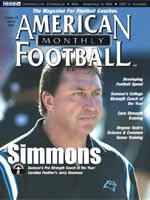AMERICAN FOOTBALL MONTHLY THE #1 RESOURCE FOR FOOTBALL COACHES
Article CategoriesAFM Magazine
|
Developing Power in the Weight Room© More from this issueAt LSU we are going to train with free weights and perform barbell exercises that require a great deal of concentration and effort. These exercises are total body exercises and require you to exert a great deal of energy every time you step into the weight room. It is important that the readers understand that we are not bodybuilders, weightlifters, or power lifters but we will perform a great deal of the same exercises that many of these great athletes do. They are, however, arranged, sequenced and prescribed in a manner that is designed for our athletes to be the very best FOOTBALL PLAYERS that they can be. The backbone of our program is built upon the weightlifting exercises. When Imention weightlifting exercises I am speaking of the snatch and clean and jerkand the many auxiliary exercises that make up an “Olympic lifters” trainingregimen. Every coach tries to recruit the biggest, strongest, quickest, mostpowerful football player possible to play on his team. Power, truly usable upperand lower body power can be developed through the use of these weightliftingexercises. Why weightlifting exercises? This question has been asked many times by coachesand players. The answer is simple; the weightlifting exercises are effective,multi-joint movements that can significantly enhance an athlete’s performancein sports that require powerful performances from a standing or crouched position.The weightlifting exercises develop in the athlete a tremendous feeling of balance,stabilization and coordination. In football, power and brute strength must bedeveloped in harmony with athleticism. When training with the weightlifting exercises the development and coordinationof the prime movers translates into the development of rate of force productionor the ability to generate force in a very short period of time. When performingthe exercises, we are not just heaving weights. It is important to discuss withthe players the timing of the different lifts and when maximum effort must beput into the bar. For instance, in our weight room we use a device that measuresbarbell speed in meters-per-seconds. This device gives the athletes immediatefeedback and allows them to make adjustments in technique to maximize the trainingeffect. The snatch is the lightest, quickest and easiest to teach of all the weightliftingexercises. We begin the teaching process by introducing the hang snatch fromthe hips, the snatch press from behind the neck and then the overhead squat.We begin teaching these exercises with an empty bar and gradually add weightas technique improves. When these auxiliary exercises are learned we move ontothe more difficult snatch variations. The power clean is the most widely recognized and used of all the weightliftingexercises. It is also classified as one of our three core lifts. We begin teachingthe clean in the same manner as the snatch, breaking it down into parts of theoriginal lift, and gradually increasing the weight of the bar. As with the snatch,when these auxiliary exercises are learned we move onto the more difficult powerclean variations. Last and certainly not least is the jerk. As a coach, I would have to say thatthis is my favorite and when done properly is one of the best total body exercisesin the weightroom. We begin the teaching process with the basic press followedby the push press and finally move onto the split jerk. There are approximately one hundred different weightlifting exercises that canbe done with a barbell. Of these one hundred, fifteen to twenty different onescan be done each month. With this many different exercises to chose from boredomand monotony should never be a problem. Teaching technique is the most important aspect of implementing weightliftingexercises into the strength-training program. It must take place in a disciplinedatmosphere and be structured so that previously learned exercises develop a foundationfor the more complex movements to follow. This takes much of the difficulty outof teaching the exercises due to the fact that our players posses a certain backgroundof technical and physical training that makes learning new skills easier. Be patient teaching athletes how to do the weightlifting exercises. Don’tmake the mistake of rushing your athletes into heavy weights before their techniqueis established. Strong but inexperienced athletes will be tempted to get aheadof their technique with weights that are too heavy for improving form. This willonly slow down their progress. From the beginning we cannot ignore the slightesttechnical errors that can lead to injuries and weaker results. Proper executionof the exercises insures against injury and will increase muscular output byeliminating poor, inefficient lifting mechanics. The back squat plays an important role in our program as well. We will squator do a squat variation every time we lift. It is the base of our program andwithout it our snatch, and clean and jerks would be very average. We also emphasizeon a daily basis the bench press and other upper and lower body exercises donewith an assortment of bars, dumbbells and machines. We also finish our workouteach day with hundreds of reps of body weight exercises ranging from chin-ups,dips, and push-ups to every conceivable abdominal exercise known to man. At LSU we lift three days a week and run four. All lifting sessions are totalbody in nature. Each workout begins with weightlifting exercises that are thenfollowed by squatting and then pressing variations. We then complete approximatelyfive auxiliary exercises in addition to core work to finish our workout. It isimportant to understand that it is the sum of all that we do – running,lifting, etc. – that determines the overall training effect, and not oneparticular part of our program is greater than the whole. |
|
| HOME |
MAGAZINE |
SUBSCRIBE | ONLINE COLUMNISTS | COACHING VIDEOS |
Copyright 2024, AmericanFootballMonthly.com
All Rights Reserved




